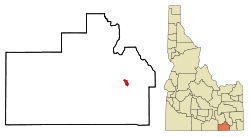Malad City, Idaho
| Malad City, Idaho | |
|---|---|
| City | |

City Hall in March 2010
|
|
| Motto: Where Idaho Begins | |
 Location of Malad City, Idaho |
|
| Location in the United States | |
| Coordinates: 42°11′27″N 112°14′57″W / 42.19083°N 112.24917°WCoordinates: 42°11′27″N 112°14′57″W / 42.19083°N 112.24917°W | |
| Country | United States |
| State | Idaho |
| County | Oneida |
| Government | |
| • Mayor | E. Spence Horsley |
| Area | |
| • Total | 1.66 sq mi (4.30 km2) |
| • Land | 1.66 sq mi (4.30 km2) |
| • Water | 0 sq mi (0 km2) |
| Elevation | 4,551 ft (1,387 m) |
| Population (2010) | |
| • Total | 2,095 |
| • Estimate (2012) | 2,037 |
| • Density | 1,262.0/sq mi (487.3/km2) |
| Time zone | Mountain (MST) (UTC-7) |
| • Summer (DST) | MDT (UTC-6) |
| ZIP code | 83252 |
| Area code(s) | 208 |
| FIPS code | 16-50140 |
| GNIS feature ID | 0396844 |
| Website | maladidaho.org |
Malad City (also commonly known as Malad) is the only city in Oneida County, Idaho, United States. Its population was 2,095 at the 2010 census, down from 2,158 in 2000.
The city is named after the nearby Malad River, the name being French for "sickly". Malad City is located along Interstate 15 on the east side of the Malad Valley 13 miles (21 km) from the Utah/Idaho border.
Established in 1864, Malad is one of the oldest communities in the state of Idaho. The community received its name from Donald Mackenzie, a Scottish-Canadian trapper, who passed through the valley between 1818 and 1821 with a party of trappers. Some of his men became sick while camped here and, believing that the illness was caused by drinking water from the valley's principal stream, he named it "Malade" meaning sick or bad in the French language. Actually, the water had nothing to do with the men's illness, as it was later learned by the second party led by Jim Bridger between 1832 and 1835. The men had most likely eaten some beaver that fed on the poisonous roots of "Water Hemlock" trees that put a naturally occurring "cicutoxin" into the animals' flesh. The beaver would have likely been immune to the poison because of long-term adaptation, but the trappers suffered from their feast. Native tribes avoided this outcome by altering food preparation methods to include boiling, which apparently deactivated the poison.
Malad began largely as a Welsh Mormon settlement whose settlers brought their Welsh traditions with them. In addition to the Mormon majority, some of the leading families in the community belonged to either the Presbyterian Church or the Reorganized Church of Jesus Christ of Latter Day Saints. These two denominations each built a place of worship in the town. Some of the minutes from early town meetings were taken down in both English and Welsh. The city is very proud of its Welsh heritage. Malad lays claim to having more people of Welsh descent per capita than anywhere outside Wales. Malad celebrated its Welsh heritage by holding an annual “eisteddfod”, patterned after the music and poetry contests held in Wales for over 900 years. The eisteddfod was an all-day event with people coming from all over southeastern Idaho. The event featured music, songs and storytelling of Wales. The custom continued until 1916 and the outbreak of World War I. With the goal of renewing the old eisteddfod tradition in Malad, in 2004, the annual Malad Valley Welsh Festival was established.
...
Wikipedia

